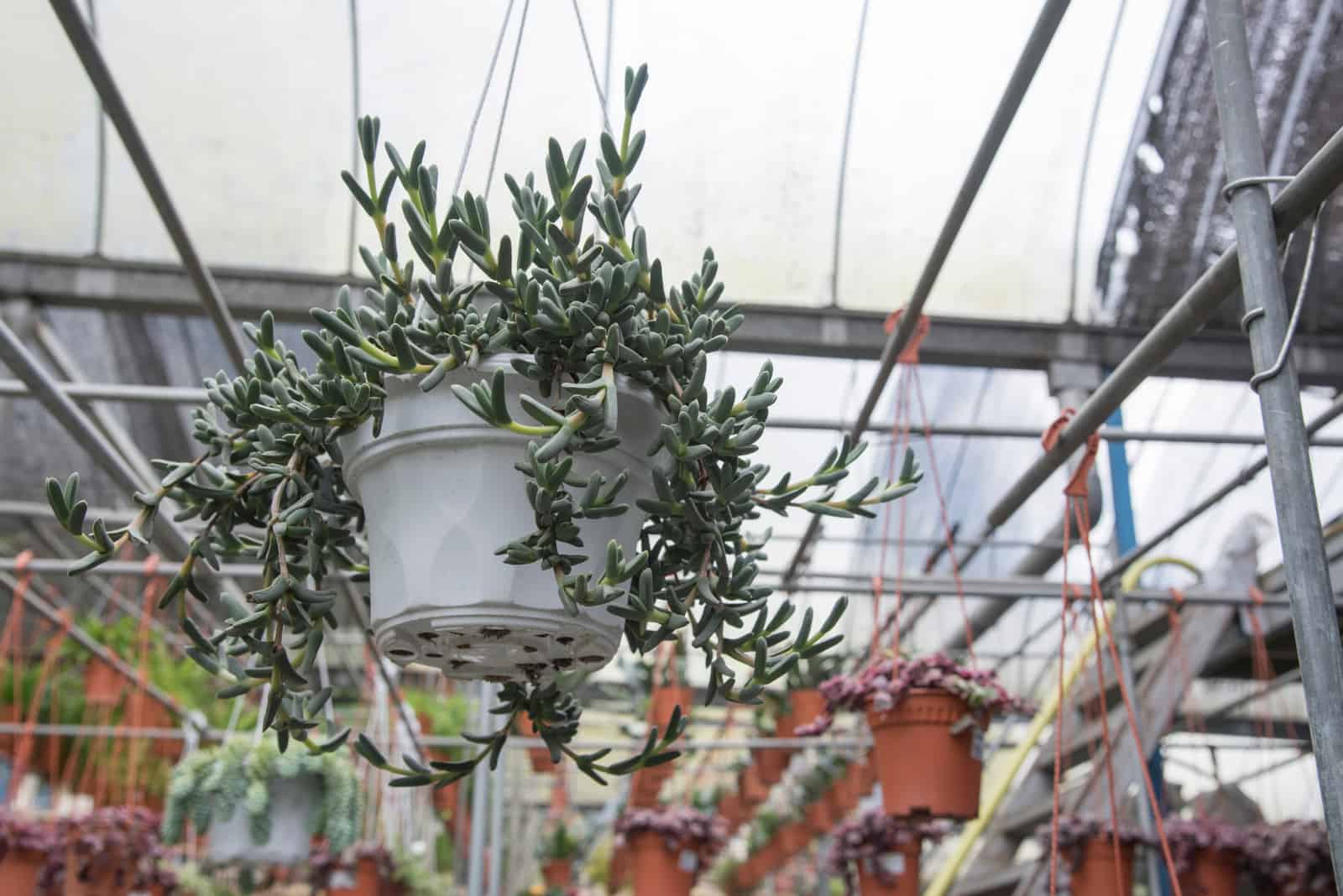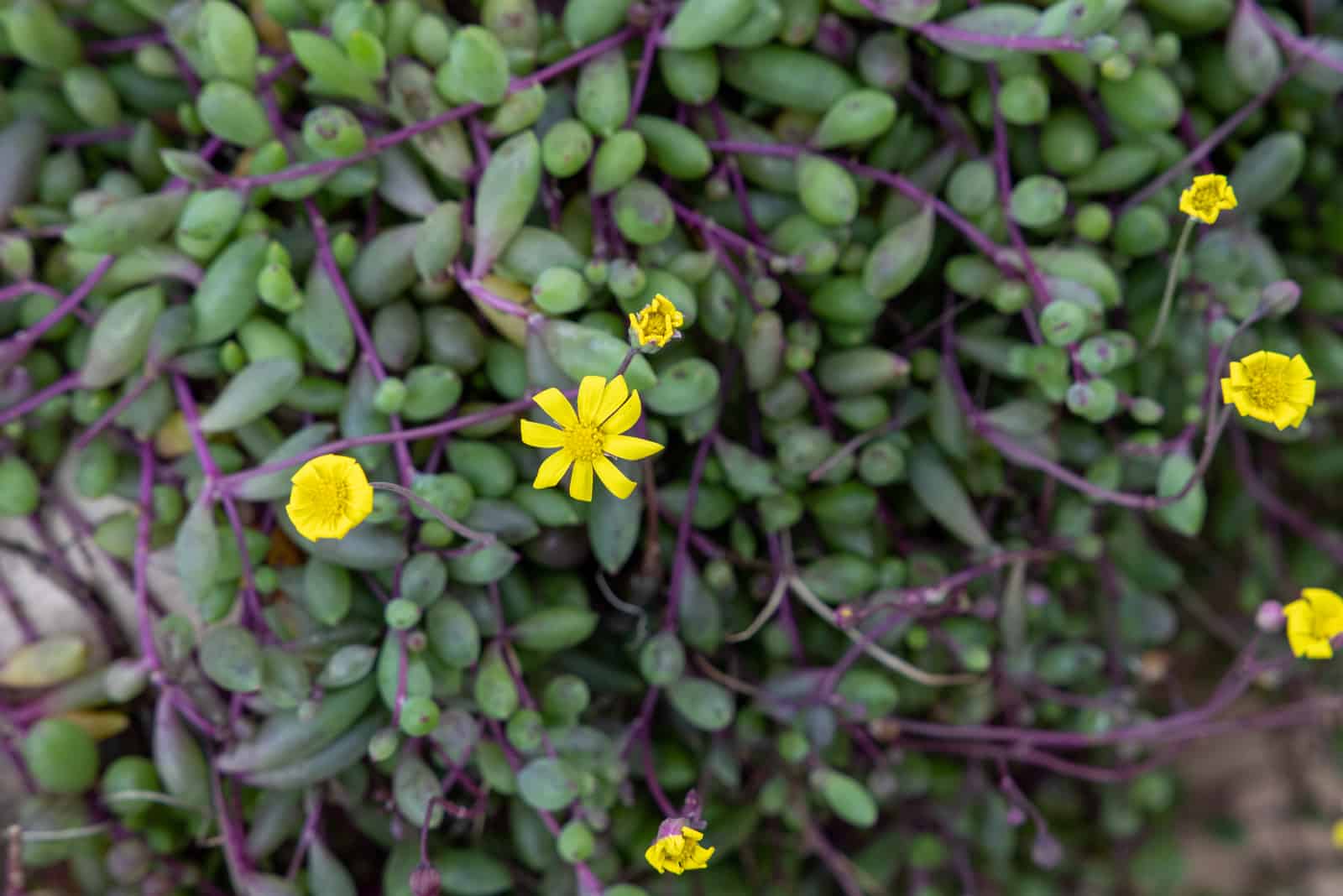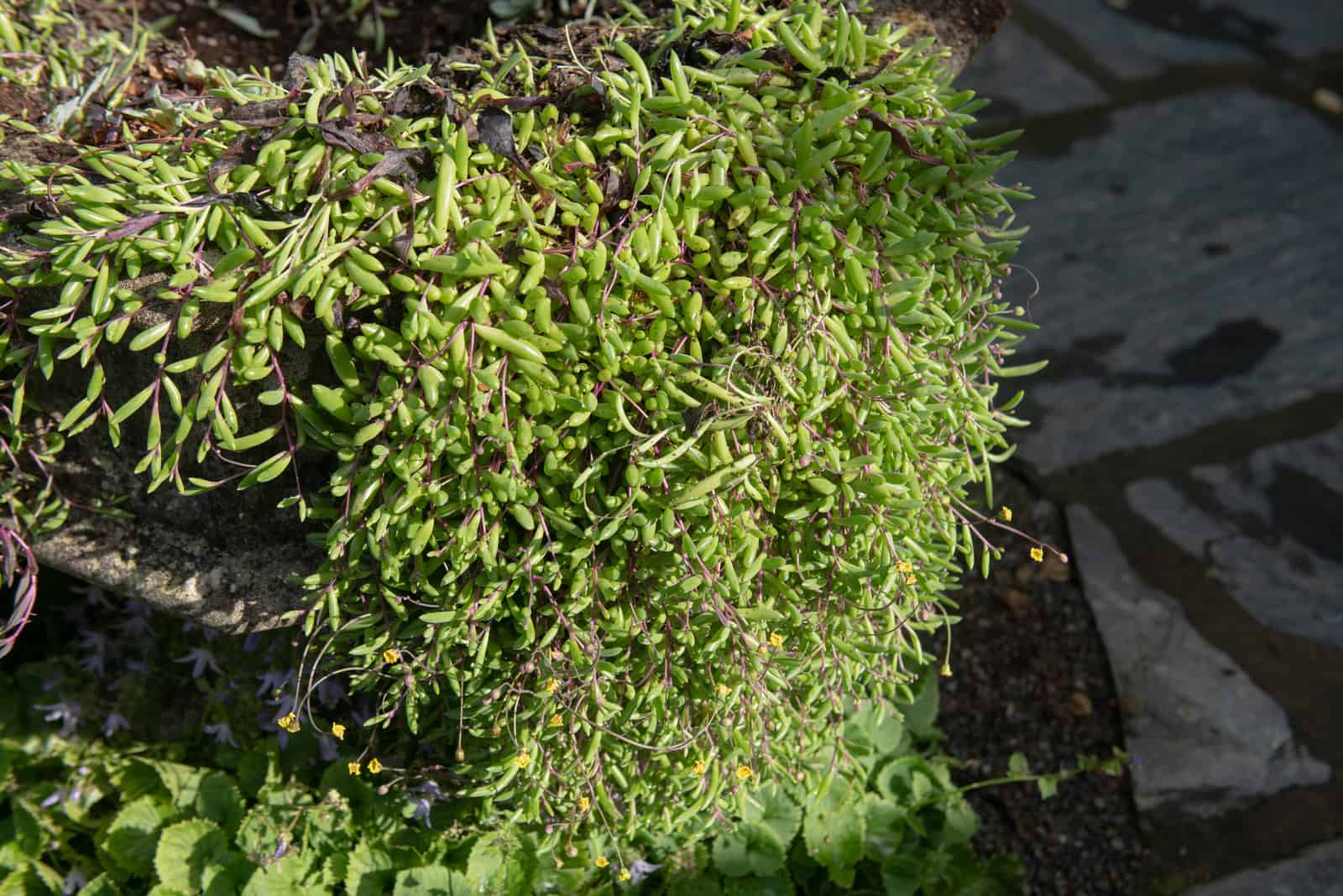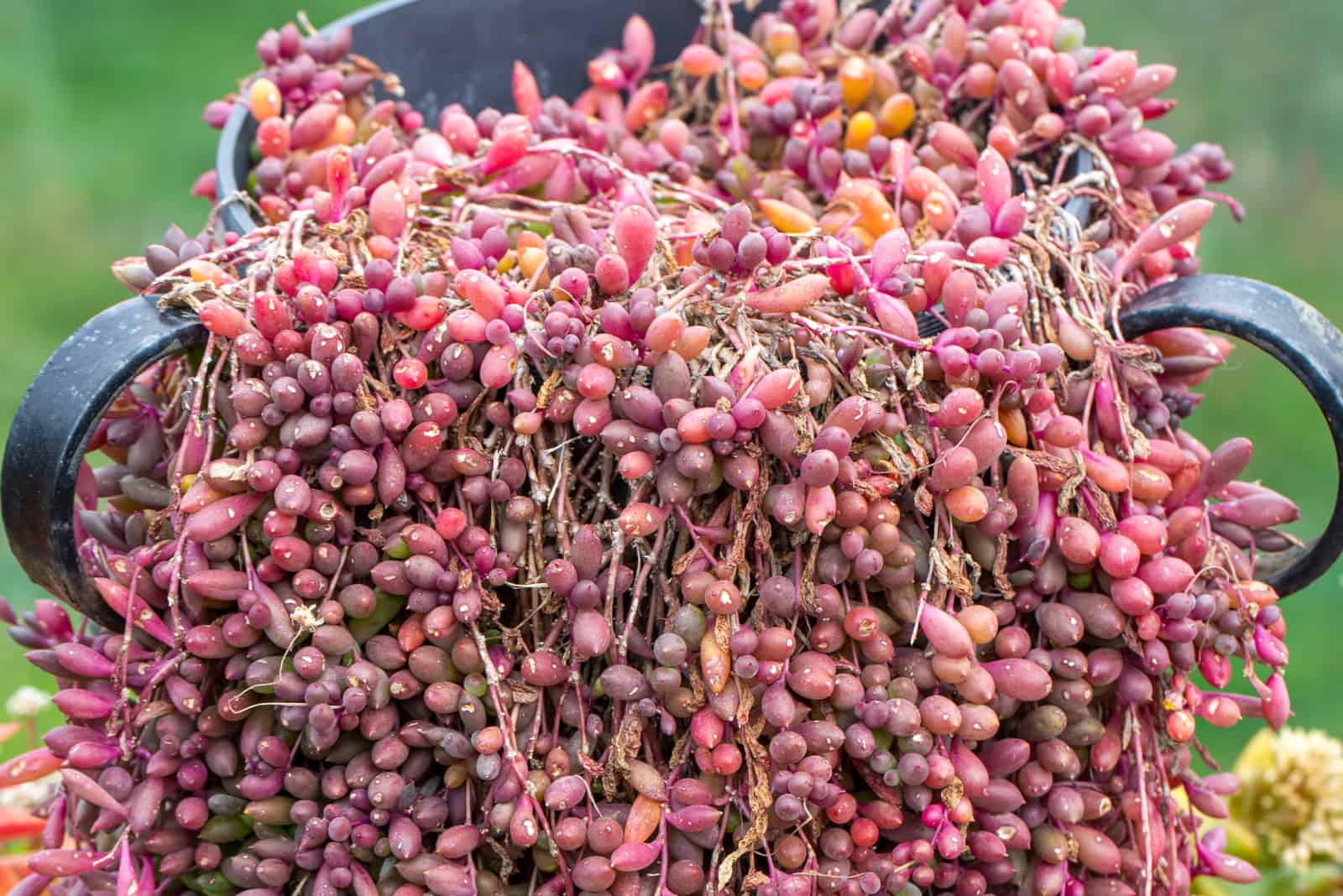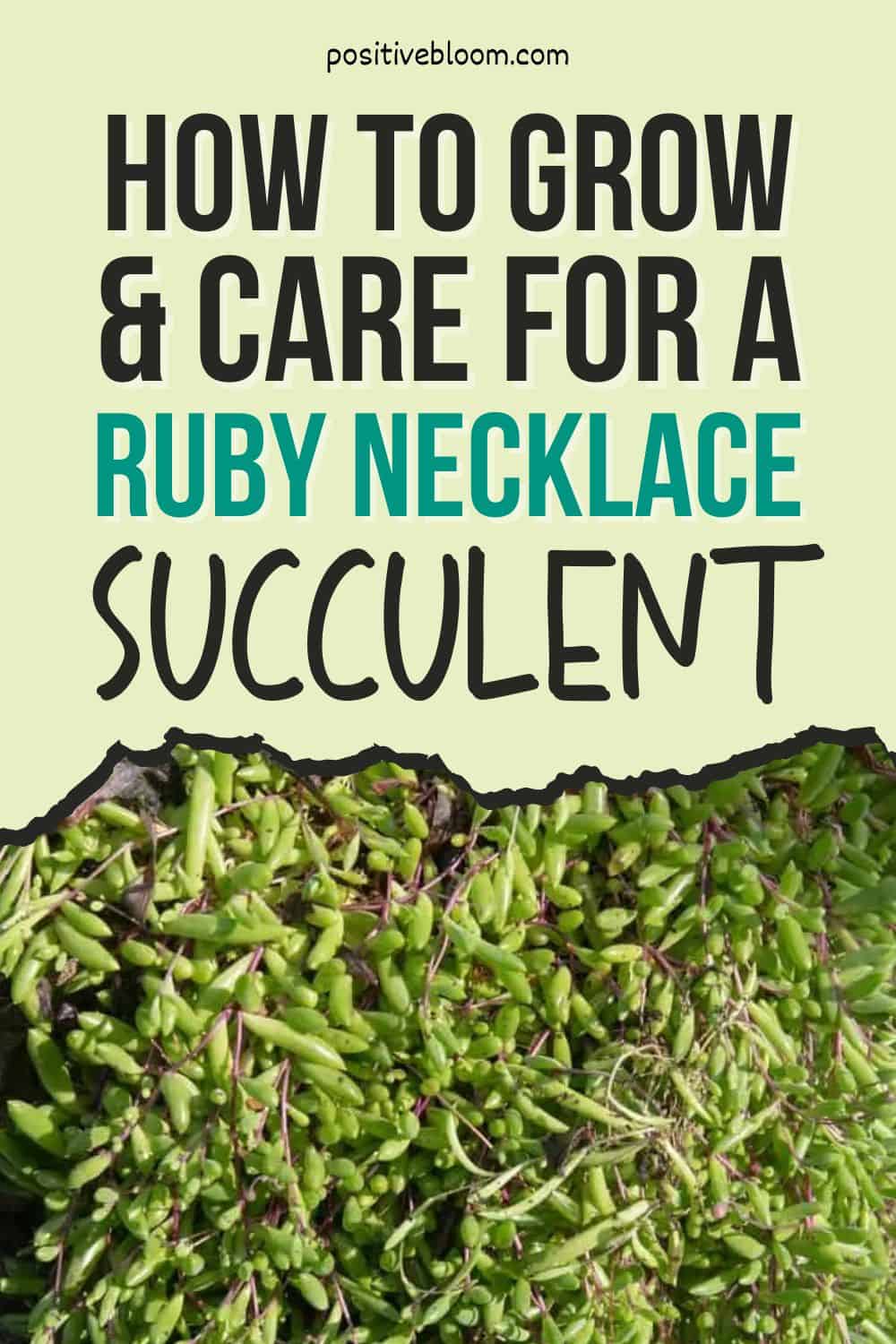The Ruby necklace has a huge number of nicknames and has become a must have for plant growers.
People often refer to it as ‘the jewel among plants’, and that’s exactly what you’ll think when you see one!
There are many reasons the ruby necklace succulent has become so popular: it’s undoubtedly beautiful, smells fantastic, has a long flowering period, and is a low-maintenance plant (which is the best part for me).
Before we move on, here’s some basic info:
[table id=166 /]
Let’s get started!
What Does The Ruby Necklace Succulent Look Like?
The ruby necklace is known for its beautiful oval-shaped leaves and reddish-purple stem. This plant is related to the Senecio genus, which includes plants like the string of pearls, string of dolphins, and string of bananas.
However, the string of rubies has one feature that makes it stand out from the other succulents. The bean-shaped leaves will turn a vivid ruby red (as the name suggests) when the plant is under stress.
This feature really makes this plant stand out amongst trailing succulents, and the vivid ruby red color is highly desired by collectors. These red cells slowly give moisture to the rest of the plant during droughts, allowing it to thrive despite a lack of water.
This plant belongs to the Asteraceae family, or the family of flowering plants. Yellow, daisy-like flowers bloom during all the seasons except winter.
The ruby string is a fast-growing plant and enters dormancy during colder seasons.
Read on to discover how to care for this fascinating plant!
Othonna Capensis Ruby Necklace Plant Care Guide
If you’re a forgetful person, this plant could be your new best friend. The little pickles plant will forgive you if you forget about it for a while, but it will reward you well if you provide it with the right conditions.
Here’s a table to give you an insight into Othonna capensis ruby plant care.
[table id=167 /]
Let’s get into details!
Light Requirements
The string of pickles is one of the rare plants that thrive in full sun. If you want to provide this plant with appropriate light conditions (and you should), ensure it gets at least 6 hours of direct sunlight per day.
If you grow this succulent outdoors, find a spot where the plant will be exposed to full sun. If you can’t find such a place, put it in partial shade instead. It will especially benefit from indirect light during the hot summer months.
When grown as a houseplant, the ruby necklace requires a sunny spot like a south-facing window. It appreciates direct sun so much that it changes its shade of red to the darkest color when exposed to it.
This plant grows in bright light, but won’t do well in low light conditions and will lose its red color and revert to green.
This means that the key to growing a healthy ruby necklace is providing it with as much light as possible.
If this is a problem, you can use a light meter and consider investing in grow lights.
Grow lights will be very beneficial, but you should still try to ensure it gets at least a little morning sun. Trust me, your ruby necklace will reward you!
Temperature Requirements
Succulent plants enjoy warm temperatures, and the ruby necklace plant is no exception.
This plant grows well at room temperature, but will struggle to survive if it ever drops below 50 degrees Fahrenheit.
Harsh winters can kill this plant, so if you grow it outdoors make sure you take it indoors to overwinter.
As this plant enjoys warm temperatures, bear in mind that it will need more water when grown in extremely high temperatures.
Heating sources are the biggest enemies of all houseplants, so make sure your little pickle is kept far away from radiators, fireplaces, and air-conditioners.
Humidity Requirements
Many beginner growers wonder if succulents need humidity. This succulent plant prefers moderate humidity, but it’s better to provide it with higher than lower humidity levels.
There are several methods for increasing humidity.
The first is investing in a humidifier, which is the safest way to monitor and increase humidity.
Other methods include terrariums, pebble trays, grouping plants, and misting.
This plant despises air drafts, so move your ruby necklace away from vents or drafty windows.
Soil
There are a couple of requirements you’ll have to meet for the ideal potting soil mix.
First, the mix should be well-draining to prevent the string of rubies from getting root rot. It’s easy to overwater, so a mix that drains fast will keep the plant safest.
The potting mix should also be porous to ensure air circulation in the soil so there is adequate oxygen supply to the roots.
String of rubies succulents prefer acidic and well-draining soil with a pH ranging from 6.0 to 6.5.
You can use commercially available cactus and succulent soil mixes for a string of rubies, or prepare your own soil mix by supplementing standard potting soil with enough perlite, sand, and/or pumice to improve drainage.
Watering
Succulents can store water in specific cells in their leaves, so it’s better to let them dry than to overwater them. The cells will release moisture and provide water to the rest of the plant, and a string of ruby plants can survive droughts because of this feature.
You can estimate the moisture content of the soil using a few different methods. You can tell if this plant needs water by sticking your finger in the soil. Deep watering the little pickle plant is essential because light watering will prevent the roots from absorbing the necessary water and nutrients.
Bottom watering is best for these plants. Placing it in a water-filled container will help you avoid overwatering while still providing the plant the water it requires. Succulents are very sensitive to water, so overwatering your string of rubies may have fatal consequences. Discover how overwatering affects its cousin, the string of pearls, right here. Allow the plant to soak in water for around ten minutes before drying it.
The growing season for these plants lasts from spring to fall, and the plants will need to be watered more frequently in this period, approximately once a week. They will need to be watered around twice a week when the weather is hot.
Water these plants once a month during the dormant season (late fall and winter) when they are not actively developing.
I recommend watering in the morning as watering at midday can cause sunburn.
Fertilizing
This succulent is perfect for beginners as it’s not a heavy feeder. However, it does benefit from being fed.
Occasional fertilizing will help the plant to grow healthy and thrive.
The best thing would be to fertilize during the growing season a couple of times.
The main thing you should pay attention to is the “NPK” ratio. This plant prefers fertilizers that aren’t rich in nitrogen.
You can choose between liquid and granular fertilizers.
If you decide to use liquid fertilizer, a few things need to be considered. First, the time of day matters so it would be best if you fertilized in the evening when temperatures are cooler. Additionally, you shouldn’t water the plant after fertilizing. If you grow this plant outdoors, try to fertilize at least two days before the rain (the weather forecast is your friend in this case).
On the other hand, if you decide to use granular fertilizer you can either apply it in the morning or evening as the temperatures are cooler. Never apply this fertilizer during the day as the sun can cause permanent damage to the plant.
Pruning
The fast growth rate of the Othonna capensis suggests that the plant will benefit from occasional pruning.
There are a couple of good reasons to prune this beautiful plant. First, you should prune to remove damaged, dead, or diseased stems as they won’t grow anymore.
Second, the vines may become tangled and affect the ruby string’s appearance.
The vines may sometimes grow in directions you don’t like, and you can direct the plant’s growth by pruning.
Lastly, you don’t want the plant to crawl all over the place, so you should prune it to limit its growth.
Always sterilize your pruners before using them as they may contaminate the plant otherwise.
Repotting
Before repotting the ruby string plant, you should first consider the pot you use.
As mentioned, the pot should have drainage holes to prevent overwatering, but the material the pot is made of also plays an essential role in the repotting process.
You can choose either unglazed ceramic or terracotta pots. Both absorb excess water, which is another good way to prevent overwatering. Additionally, these materials are porous so air circulation won’t be a problem.
I have to mention that these materials are heavy, and adding soil and plants to the pot will make it even heavier.
Fresh soil is essential for repotting. Old soil may not have the nutrients the plant needs anymore, so you’ll ensure it gets the necessary nutrients and also avoid contamination by using fresh soil.
The first step of repotting is removing the ruby string from its pot. After taking it out of the pot, it’s time to remove the excess soil from around the roots.
Take fresh soil and fill the new pot with it about half way. Place your ruby string into the pot and add more soil until it’s full.
I suggest placing the plant in the morning sun after repotting to help avoid transplant shock.
The great thing about these succulents is that they actually prefer being rootbound, so they won’t mind if you wait 2 or 3 years to repot them.
How To Propagate A String Of Rubies
The ruby string plant can be propagated by stem cuttings in soil or water, by division, and also from seeds.
Propagation by stem cuttings has a higher success rate as water propagation may cause root rot. If you’re a beginner at growing plants, I suggest you propagate the ruby string by stem cuttings in the soil.
Other propagating methods include seeds and roots.
Let’s get into details!
Stem Cuttings
Before we look at propagation by stem cuttings in soil or water, let’s see how and when to take the cuttings.
The best idea would be to take cuttings in the spring or summer months when the ruby string is growing actively.
Follow these steps to take stem cuttings.
1. Find a suitable spot on your ruby string and make sure the selected cutting is healthy and has at least one node attached to it.
2. Make a quick and even cut through the stem using sterilized pruning shears. Take as many cuttings as you want new ruby string plants.
Now that you have the cutting (or cuttings), let’s find out how to propagate it in water.
Stem Cuttings In Water
1. Fill a glass or jar with water. You can keep an eye on root development by using clear containers like small jars or vases
2. Remove the bottom leaves from the stem cuttings to reveal the stem and nodes then immerse the stem end in water. At least 1-2 nodes should be submerged in water.
3. Change the water in the container each week, or more often if you notice it’s getting brown or has an unpleasant smell as this could mean that some roots have rotted. Any rotten roots should be removed to avoid disrupting the propagation process.
4. Place the container with water and cuttings in bright indirect light and wait until you notice the new growth of roots. New roots may sprout in about a week if provided with the right conditions.
5. It’s now time to repot the ruby string.
Stem cuttings In soil
Prepare a succulent or cactus mix and a stem cutting.
1. Make a small hole in the center of the fresh soil.
2. Place the ruby string cutting in the hole and press the soil down slightly to help the cutting stay upright.
Make sure there aren’t any leaves planted in the soil as they could rot and cause the propagation to fail.
3. Place the container in indirect light and mist the soil regularly. Bear in mind that waterlogged soil will cause the roots to rot after sprouting, so be careful with misting.
4. Repot your new ruby string.
Here’s a video showing you how:
Propagation From Seeds
Seed propagation of the ruby necklace plant is not only possible, but also simple.
Seed pods can be found at the tips of completely dried blooms, and should be carefully removed.
Some harmful bacteria may be present in the soil, so you can sterilize it by placing it in the microwave for 1-2 minutes.
Plant the seeds in the top layer of soil after drying them.
Indirect sunlight or growth light is ideal for germination. Cover it with a plastic or glass lid to keep the soil evenly moist.
It will produce small saplings after a month, which can be transplanted to a larger container.
By Division
Root propagation of the ruby necklace plant is also straightforward.
The plant will grow long branching stems and develop aerial roots during this stage.
After the aerial roots are developed, make a cut about 1 inch below the root. Use a sharp and sterilized cutting tool like scissors or shears. Wait for approximately 1 to 2 hours before potting it into wet soil.
Place it in bright indirect light.
Common Issues
A couple of issues may affect your Othonna capensis ruby necklace. Luckily, this plant isn’t prone to many diseases, but I’ll show you how to deal with them if they do occur.
Pests And Diseases
There are two pests that can affect the ruby necklace: mealybugs and scales. These pests are attracted by the nutrients in the fleshy leaves and they feed on the nutrients. When these pests infest the plant, it may lose all the nutrients it needs.
To prevent these pests from sucking the sap, I suggest regularly inspecting the plant as part of your normal ruby string succulent care.
However, if your Othonna capensis is already infested, there are a couple of methods you can use to get rid of these annoying sap-suckers.
First, you can use isopropyl alcohol. Dip a soft sponge in it and gently rub the string of rubies leaves.
You can use neem oil for treating both mealybugs and scales.
Another method is mixing insecticidal soap with water and spraying it on the leaves.
Luckily, the ruby string isn’t prone to disease. The most common disease that affects the ruby string is root rot. The roots will start turning brown or black and the soil will become mushy.
Root rot is a consequence of overwatering, so to prevent the disease from affecting your plant, change your watering habits and adjust them to the ruby strings’ needs.
The Story Behind The Ruby Necklace Succulent
South Africa’s indigenous tribes have always respected and worshiped the string of rubies. It was thought to have protective properties and was used as a medicinal plant.
This succulent was used for food and making jewelry, and some even brewed it into wine and teas.
The icing on the cake is that the ruby necklace produces daisy-like flowers that are the national flowers of Tanzania!
Europeans didn’t get to enjoy the string of rubies until the 17th century when it was brought over via cargo ship.
FAQs
Is The Little Pickle Plant Toxic?
The little pickle is mildly toxic to humans and pets. Luckily, it’s mostly grown in hanging baskets so it’s often out of the reach of small children and pets.
Is the ruby Necklace succulent rare?
The othonna capensis is a rare plant. It’s feature of changing the color of its leaves when exposed to direct sunlight is what caused its popularity. Many want it as part of their plant collection, but it’s not easy to get one. Luckily, it’s easily propagated, so if you do manage to get one, make sure you grow a lot of new ones!
Is the ruby Necklace a cactus?
The Ruby necklace isn’t a cactus, it’s a succulent. Cactus plants belong to the Cactaceae family and are all succulents. Still, not every succulent is a cactus, which applies to the string of rubies.
What is the meaning of the name “Ruby Necklace”?
The othonna capensis has ruby red leaves when exposed to direct sunlight. As it’s a trailing plant, it resembles a necklace made of rubies.
What is the difference between a ruby Necklace and a succulent?
There is no difference between the two. The ruby necklace is a trailing succulent plant grown in hanging baskets, but it’s also suitable for a rock garden. If you plant a ruby string outdoors it will grow as ground cover directly in the soil.
Wrapping Up
After reading this article, I’m sure you won’t want to wait too long to get a ruby necklace succulent for yourself!
And you’re not the only one! It’s on the wishlist of many plant growers, and honestly, who could resist the ruby red leaves? I certainly couldn’t.
Take good care of your Othonna capensis, propagate it, and make sure you don’t overwater it, and you’ll be golden.
Until next time!
Like this post? Share or pin it for later!

